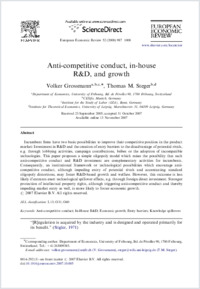Anti-competitive conduct, in-house R&D, and growth
BP2-STS
- Grossmann, Volker ORCID University of Fribourg
- Steger, Thomas M. University of Leipzig
- 2008
Published in:
- European Economic Review. - Elsevier BV. - 2008, vol. 52, no. 6, p. 987-1008
Anti-competitive conduct
In-House R&D
Economic growth
Entry barriers
Knowledge spillovers
Economics and Econometrics
Finance
English
Incumbent firms have two basic possibilities to improve their competitive position in the product market: Investment in R&D and the creation of entry barriers to the disadvantage of potential rivals, e.g. through lobbying activities, campaign contributions, bribes or the adoption of incompatible technologies. This paper proposes a simple oligopoly model which raises the possibility that such anti-competitive conduct and R&D investment are complementary activities for incumbents. Consequently, an institutional framework or technological possibilities which encourage anti-competitive conduct, although impeding entry of potential rivals and accentuating standard oligopoly distortions, may foster R&D-based growth and welfare. However, this outcome is less likely if entrants exert technological spillover effects, e.g. through foreign direct investment. Stronger protection of intellectual property rights, although triggering anti-competitive conduct and thereby impeding market entry as well, is more likely to foster economic growth.
- Faculty
- Faculté des sciences économiques et sociales et du management
- Department
- Département d'économie politique
- Language
-
- English
- Classification
- Economics
- License
-
Rights reserved
- Open access status
- green
- Identifiers
-
- DOI 10.1016/j.euroecorev.2007.10.005
- ISSN 0014-2921
- Persistent URL
- https://folia.unifr.ch/unifr/documents/323700
Statistics
Document views: 82
File downloads:
- 1-s2.0-s0014292107001481-main-1: 148
